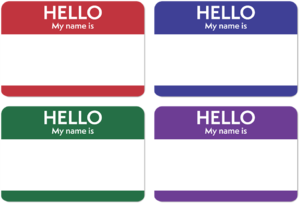Difference between revisions of "Documentation:Teaching English as an Additional Language"
| Line 112: | Line 112: | ||
* [http://linguistics.byu.edu/faculty/henrichsenl/LessonPlanning/lp_12.html Introduction & Presentation] | * [http://linguistics.byu.edu/faculty/henrichsenl/LessonPlanning/lp_12.html Introduction & Presentation] | ||
* [https://eltplanning.com/2015/06/22/35-ways-to-introduce-your-lesson-topic/ 35 Ways to Introduce Your Lesson Topic] | * [https://eltplanning.com/2015/06/22/35-ways-to-introduce-your-lesson-topic/ 35 Ways to Introduce Your Lesson Topic] | ||
| + | |||
| + | =Practice= | ||
| + | ==Vocabulary Activities=== | ||
| + | *[https://www.englishclub.com/vocabulary/sports.htm Vocabulary for Specific Sports]: This website give an overview of the history of the sport, the rules, vocabulary lists, as well as quizzes. | ||
Revision as of 13:09, 5 October 2016
Lesson Planning
Warm Up Activities
Resources for Warm-up Games
Ice-breakers / Introductions
Alliteration Name Game In this game, students will say their name and then a word that describes them, but that word must start with the first letter of their name. They must also come up with an action to describe themselves. This is also a memory game. The first student will say for example, “My name is Kelly and I like kayaking (show motion of kayaking). The next student introduces themselves and repeats what the previous person stated. E.g. My name is Ana and I like art (motion of painting) Her name is Kelly and she likes kayaking. The game continues until all students have participated.
My World Draw a circle on the board and ask students what they think it is. After hearing their answers, tell them it represents your world. Write ‘My World’ above it. Then write a few words and/or phrases inside the circle that represent some things in your life (i.e.1980, elves, 5 years). Ask students what they think the words mean. Once they tell you their ideas, give them the correct answers (i.e. 'I love reading books with elves, etc.). Next, hand out blank pieces of paper and have the students draw a circle and label it as My World. Ask them to write 5-8 words/phrases that describe themselves. Put them in groups of 4 and ask them to guess about each other's 'worlds'
Partner Interview Put students into pairs and tell them they will interview their partner and present them to the class. Include what town they are from, what grade they want to teach, and 2 other interesting facts they want to share (use `My World`` info). After 10 minutes, ask pairs to stand up and share about their partner.
Two Truths and a Lie Ask each student to write down two sentences that are true about him or her and one sentence that is false. Then have the students read their list while the others listen and decide which one they think is a lie. Cycle through all the students.
Warmers
Vocabulary Activities
Around the World
The teacher shows the flash card and the first student that answers correctly moves on to the next desk where both students stand: thereby going around the world (class) until everyone has a chance to play. Pictionary Divide students into two groups. Explain that the game Pictionary is a guessing word games where teams try to guess what their team member is drawing (e.g. draw a book). For advanced students, give an example of something related to teaching that you will ask them to draw (e.g. Students are taking a test). Model that they can draw the noun, but the team should guess a full sentence. Have one student from each group come up to the board and give them the same sentence to draw a picture of. Remind the class to give the answer in full sentences (ex. Not simply ‘book’, but “a student is reading a book”).
Charades Split the class into two teams and have one student at a time come up to the front and act out a card. For the team to guess correctly, they must use the infinitive or gerund (either “To swim in the lake” or “Swimming in the lake”)
Animal Fight For this activity, you will need to prepare small animal flashcards. Put students into group of 3 and ask them to choose one leader. Give the leader the deck of animal flashcards and separate the piles evenly into two. Explain that this game is called “Animal Fight!” The other two members of the group will take a pile (cards facedown), and when the leader says “Attack!” they will each flip the top card. Next, the two students have to agree which animal would win in a fight, and give a reason (e.g. The lion would win because he is stronger and faster). If the two cannot agree, the leader will judge based on the more convincing argument. The winner of the fight gets to keep both cards, which are placed at the bottom of his/her pile. When the leader says “Attack!” they flip the next card over and repeat the process. If there is time, students can switch roles so the leader can play as well.
Around the World The teacher shows the flash card and the first student that answers correctly moves on to the next desk where both students stand: thereby going around the world (class) until everyone has a chance to play.
Shiritori Put students into teams and write a word on the board. Explain that for this game they will look at the last letter and make a new word starting with that letter eg. English, happy, yesterday, yellow, water, rhinoceros, etc. Use an online stopwatch and give students 3 minutes to write their list. Modifications include 4+ letter words, not repeating words, etc.
Alphabet Race In teams, students have 2-5 min. to find an item within the room that begins with each letter of the alphabet. The team with the most wins. To make it harder, do it in alphabetical order.
Scategories\\\ Give students a list of categories (sports, celebrities, things at a park, etc.) and then choose a letter (B). Students have 2 minutes to write creative answers (baseball, Billy Bob Thorton, bugs). After, talk about the answers. Students only get points for original answers.
Speaking Activities
1-minute Dice Conversations Draw pictures of dice on the board (see example). Make a list of 6 discussion topics (i.e., hobbies, favourite food, travel, family, jobs, favourite person, etc.). Put the students in groups of 2-4 and have one of them role a die. The number showing decides the topic for him/her to discuss for 1 minutes. The next student roles the dice and repeat the process. However, if the same number shows, they must role again. Alternatively, students must say three sentences about the topic, and if they role again, they cannot repeat what they’ve said.
Line Up Ask the students to form a single straight line, according to birthdays. For example, persons with January birthdays will be at the beginning of the line, earliest January dates first followed in order by later dates. The line progresses by months and days with December birthdays at the end. Persons with the same birthday share the same place in line. When the line is completed, each person will shout out his/her birthday, beginning in January. Continue the line up game with other categories, for examples height, age, siblings, etc.
Tongue Twisters Prepare cards with tongue twisters. Give each student a card and ask them to find a partner and say the tongue twister.
Grammar
Go Fish To practice ‘some’ and ‘any’ in questions, prepare paired cards; one with a picture of an item (eg. food) and the other with the word. The students first do matching to learn the vocab and then play Go Fish. The students take turns asking "Do you have any X?" The other student either replies "Yes, I do" or "No, I don't." Optional: Another round can be played by asking: "Can I have some X?" This way the students see the difference between some and any in the question. This time the response is "Yes, you can, Here you go." or "I'm sorry. I don't have any X" This game works great to teach food vocabulary and the some/any distinction.
Team-Building Activities
Count Off Ask the group to count to 20 without pre-planning who is going to say each number. There is a catch....there are no verbals or signals allowed, and the group must do it without any two people saying the number simultaneously. See how fast they can do it!
Follow the Leader This activity can be used to promote leadership and team building skills. Have students sit in chairs in a circle and ask one student to leave the room and wait in the hallway. In the classroom, choose a leader who will start a movement that everyone must copy (clasp hands, rub head, snap fingers, slap laps, etc.). The trick is that students should try not to look directly at the leader, but at someone else across the circle. As the leader starts the movement, ask the one student in the hall to come back into the classroom and guess who the leader is. After 2-3 rounds, ask for other tips that make a good leader (slow movements, change the motion when the person is not looking, etc.) Ask the following questions: Who was eventually copied and why? What steps did you take to conform to the same position? How comfortable was it to become exactly like everyone else or to go along with the peer pressure? Who resisted and why? At the end of the game, discuss the qualities of a great leader.
We're Going Camping! Introduce the game with the phrase, "Hello. My name's Kelly and we're going camping! I'm going to bring a kayak!" First letter of your name matches the first letter of the item you are bringing. The first student is coached to say, "Hello. My name is (D-----) and we're going camping! Kelly is bringing a kayak and I'm going to bring (d------)!" The next student says, "Hello. My name is (Y-----) and we're going camping! Kelly is bringing a kayak and D--- is bringing d--- and I'm going to bring (y------)!". This continues around the room, names and items added, with the teacher repeating the whole list at the end (hopefully).
1,2,3,Stare! Have students sit or stand in a circle and make sure they can see everyone. Next, have students look down until you say “1,2,3,Stare!” Students must look at one person only, and the students who are looking at each other are out.
Class Posture Ask the class to all get in the exact same position, every body part placed identically to everyone else's. Possible processing questions: Who was the leader? What was the plan? How did you work together? How comfortable was it to conform or follow others? Who resisted and why?
More Games & Resource Links
- Helium Stick: http://www.wilderdom.com/games/descriptions/HeliumStick.html
- Think, Pair, Share: https://www.teachervision.com/group-work/cooperative-learning/48547.html
- Who’s the Leader – Hand squeeze: http://www.bbbpress.com/2013/02/whos-the-leader/
Vocabulary
Flashcards
- Priorities For Teaching English These flashcards review the vocabulary in Chapter 1 of Penny Ur's English Language Teaching.
- Introduction To Kamloops (Esl Vocabulary) These flashcards review the vocabulary from the Venture Kamloops video Available at: https://www.youtube.com/watch?v=AVga76CFpuc.
Introduction & Presentation
Practice
Vocabulary Activities=
- Vocabulary for Specific Sports: This website give an overview of the history of the sport, the rules, vocabulary lists, as well as quizzes.

